Log in
Search
Latest topics
» Tee Dee .020 combat modelby rdw777 Today at 9:35 am
» Free Flight Radio Assist
by rdw777 Today at 9:24 am
» My latest doodle...
by batjac Yesterday at 9:47 pm
» My N-1R build log
by roddie Yesterday at 8:50 pm
» Purchased the last of any bult engines from Ken Enya
by getback Yesterday at 12:05 pm
» Funny what you find when you go looking
by rsv1cox Wed Nov 20, 2024 3:21 pm
» Landing-gear tips
by 1975 control line guy Wed Nov 20, 2024 8:17 am
» Cox NaBOO - Just in time for Halloween
by rsv1cox Tue Nov 19, 2024 6:35 pm
» Canada Post strike - We are still shipping :)
by Cox International Tue Nov 19, 2024 12:01 pm
» Duende V model from RC Model magazine 1983.
by getback Tue Nov 19, 2024 6:08 am
» My current avatar photo
by roddie Mon Nov 18, 2024 9:05 pm
» Brushless motors?
by rsv1cox Sun Nov 17, 2024 6:40 pm
Cox Engine of The Month
The Strato Bug -Identifying originality
Page 1 of 2
Page 1 of 2 • 1, 2 
 The Strato Bug -Identifying originality
The Strato Bug -Identifying originality
This has been discussed in several recent topics but the "i"s haven't been dotted and the "t"s crossed.
The Strato Bug is a firm collectors favourite but is is now approaching 60 years old and, only having been produced for a short time, 1954 (a glorious year for being born, only for the best of the best!) til 1956.
This period could lead to several anomolies in identification that could or could not be original or subsequent changes due to the maintenance of a short lived production to keep one running.
I am trying to avoid the word "fake" although I realise there have been reproduction tanks made but, again, identificaion of an original tank has not be clearly defined.
It is obvious that the definitive Strato bug only parts are the tank and the back plate. The reproduction tanks that I have seen have one notable failing - here is a picture of a genuine one:-
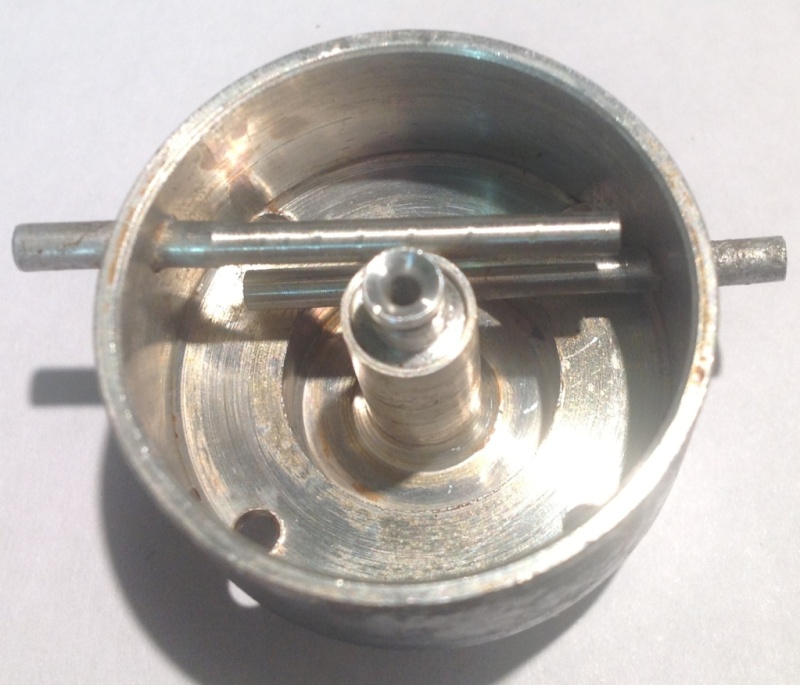
It is not clear from the photograph (it was copied from another topic) but the intake is different to the tanks produced for the Bug Jrs. A closer inspection shows why the mating hole in the backplate is larger. The intake is fluted and has a groove for an "o" ring part way down to form the seal within the hole in the backplate. Not by pressure at the point where the tank intake widens as on the Bees and the Bug Jrs.
The period of production would indicate that the cylinder would have been Thin Walled and have used the smaller threaded head. However, 1956 was a change year when the larger threaded head started to be used. The two versions of head and cylinder when screwed together are difficult to spot in any photograph.
Similarly, Tim and Dans handbook indicates the use of twin bypass cylinders. Again, who would be to know what was actually assembled on an original?
Certainly, with the demise of the small threaded head - owners may have ben tempted to replace the head and cylinder with available parts. Would this be or not be a Strato Bug?
The strangest question I would have is concerning the crankcase. In the above mentioned book the picture on the rear cover shows the crankcase with the lip (while still in the packet). The one inside the book - pg 35 - appears not to have a lip! (Both red backplates)
The picture here of one in a packet (different source) has no lip.

While this yellow one has a lip.
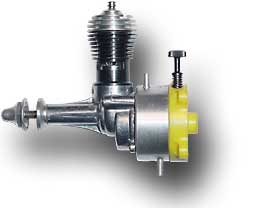
Therefore, leaving the tank and backplate to one side:-
1. Is the cylinder definitely twin bypassed?
2. Were all Strato Bugs equipped with the smaller threaded heads?
3. Were the crankcases "lippy" or not?
The Strato Bug is a firm collectors favourite but is is now approaching 60 years old and, only having been produced for a short time, 1954 (a glorious year for being born, only for the best of the best!) til 1956.
This period could lead to several anomolies in identification that could or could not be original or subsequent changes due to the maintenance of a short lived production to keep one running.
I am trying to avoid the word "fake" although I realise there have been reproduction tanks made but, again, identificaion of an original tank has not be clearly defined.
It is obvious that the definitive Strato bug only parts are the tank and the back plate. The reproduction tanks that I have seen have one notable failing - here is a picture of a genuine one:-

It is not clear from the photograph (it was copied from another topic) but the intake is different to the tanks produced for the Bug Jrs. A closer inspection shows why the mating hole in the backplate is larger. The intake is fluted and has a groove for an "o" ring part way down to form the seal within the hole in the backplate. Not by pressure at the point where the tank intake widens as on the Bees and the Bug Jrs.
The period of production would indicate that the cylinder would have been Thin Walled and have used the smaller threaded head. However, 1956 was a change year when the larger threaded head started to be used. The two versions of head and cylinder when screwed together are difficult to spot in any photograph.
Similarly, Tim and Dans handbook indicates the use of twin bypass cylinders. Again, who would be to know what was actually assembled on an original?
Certainly, with the demise of the small threaded head - owners may have ben tempted to replace the head and cylinder with available parts. Would this be or not be a Strato Bug?
The strangest question I would have is concerning the crankcase. In the above mentioned book the picture on the rear cover shows the crankcase with the lip (while still in the packet). The one inside the book - pg 35 - appears not to have a lip! (Both red backplates)
The picture here of one in a packet (different source) has no lip.

While this yellow one has a lip.

Therefore, leaving the tank and backplate to one side:-
1. Is the cylinder definitely twin bypassed?
2. Were all Strato Bugs equipped with the smaller threaded heads?
3. Were the crankcases "lippy" or not?

ian1954- Diamond Member

- Posts : 2688
Join date : 2011-11-16
Age : 70
Location : England
 Re: The Strato Bug -Identifying originality
Re: The Strato Bug -Identifying originality
Mark kindly pointed me to his web site and from that I gleaned the following:-
Strato Bug
It used the same core engine as the Space Bug, so it was dual ported. The engine was available in red, yellow, and blue. The glowhead was modified from the smaller diameter “302” head to the larger diameter "302-A1,” in Feb 1955. (Later known as the “302-A, and “302-1”) Cox's practice was to deplete the stock of older parts, either by installing the part on the products, or packaging them as replacement items.
So I would conclude that all cylinders were twin ported but could be assembled using both sizes of head.
I have also filched the following pictures :-
A yellow one with a lipped crankase
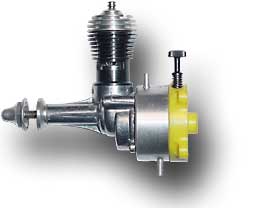
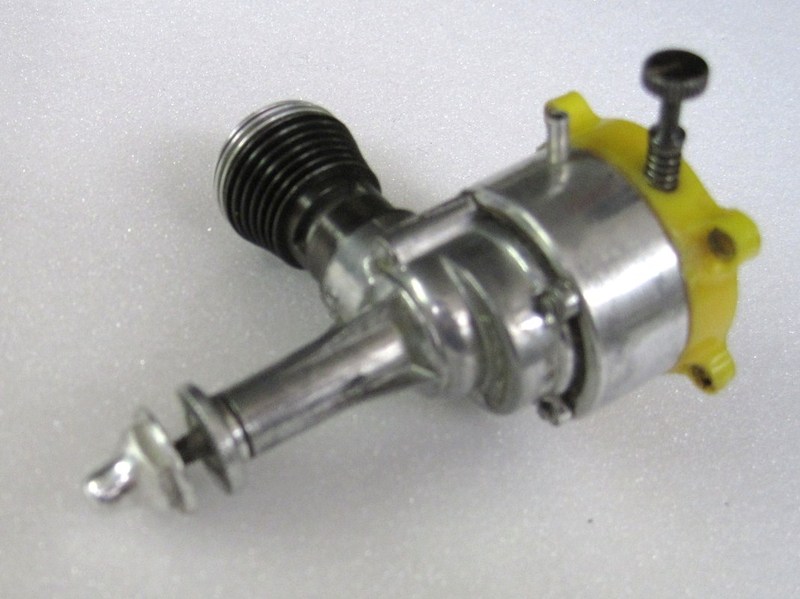
and a red one without a lip
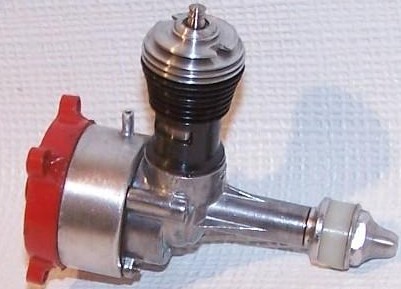
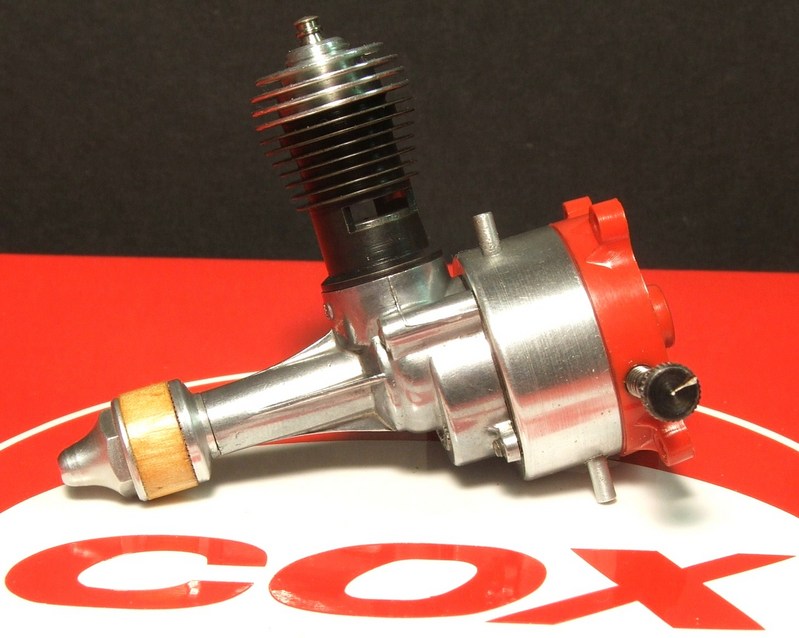
Thank you Mark
Strato Bug
It used the same core engine as the Space Bug, so it was dual ported. The engine was available in red, yellow, and blue. The glowhead was modified from the smaller diameter “302” head to the larger diameter "302-A1,” in Feb 1955. (Later known as the “302-A, and “302-1”) Cox's practice was to deplete the stock of older parts, either by installing the part on the products, or packaging them as replacement items.
So I would conclude that all cylinders were twin ported but could be assembled using both sizes of head.
I have also filched the following pictures :-
A yellow one with a lipped crankase


and a red one without a lip


Thank you Mark

ian1954- Diamond Member

- Posts : 2688
Join date : 2011-11-16
Age : 70
Location : England
 Re: The Strato Bug -Identifying originality
Re: The Strato Bug -Identifying originality
Dont know if this helps or already has been mentioned but the Space Bug Jr, which was made with the same crankcase as the Strato Bug, shares the same difference in the crankcase as noted above.. the Space Bug Jr. has a liped and un-liped crankcases aswell. I think as you mentioned... Cox was using these crankcases until one style ran out?...Kind ofmakes sense, from a production stand point, to use up excessive inventory..Question now is: What was the first production run of the Strato Bug, a liped crankcase or un-liped crankcase??....Or!! Were these two different style crankcases being assembled on the Strato Bug and Space Bug Jr. all mixed together throughout the entire production run of these engines?  Here is a Red Strato with a lipped crankcase.
Here is a Red Strato with a lipped crankcase.
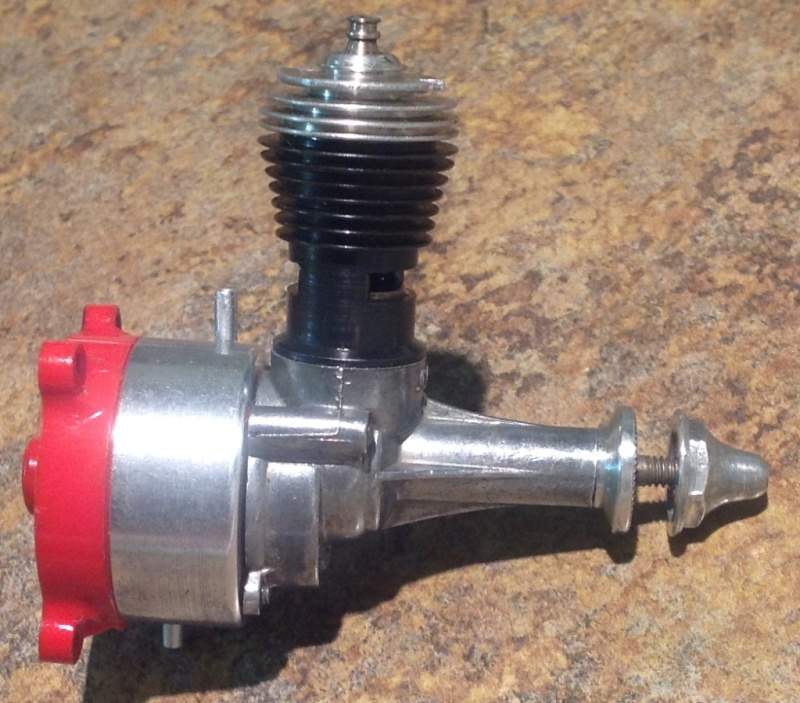
 Here is a Red Strato with a lipped crankcase.
Here is a Red Strato with a lipped crankcase.

ZACATTACK- Gold Member

- Posts : 328
Join date : 2012-04-15
 Re: The Strato Bug -Identifying originality
Re: The Strato Bug -Identifying originality
The lip is at the fuel tank on the case? It isn't very obvious.
Phil
Phil

pkrankow- Top Poster

- Posts : 3025
Join date : 2012-10-02
Location : Ohio
 Re: The Strato Bug -Identifying originality
Re: The Strato Bug -Identifying originality
https://www.coxengineforum.com/t4219-cox-cylinder-pre-1955-which-fit-small-thread-head
Pictures in this thread makes it more obvious.
Pictures in this thread makes it more obvious.

pkrankow- Top Poster

- Posts : 3025
Join date : 2012-10-02
Location : Ohio
 Re: The Strato Bug -Identifying originality
Re: The Strato Bug -Identifying originality
pkrankow wrote:The lip is at the fuel tank on the case? It isn't very obvious.
Phil
Obvious or not, it's there, and it's weird!! Two engines ( Strato and Space Bug Jr.)made with two different looking crankcases. All I know is Cox was a one strange kind of engine producing company with lots of hidden agenda throughout decades of production. It's subject for another thread, but certain procedures Cox executed in operating and the manufacturing of engines makes absolutely no sense to me at all.

ZACATTACK- Gold Member

- Posts : 328
Join date : 2012-04-15
 Re: The Strato Bug -Identifying originality
Re: The Strato Bug -Identifying originality
It is not as strange as it appears.
First of all, it is not two engines but four. The Space Bug, Space Bug Jr, Strato Bug and the Thermal Hopper. All utilise the same crankcases.
We are talking about a mass production line and the manufacture of thousands of engines at (what was at the time) probably a quarter of the cost of a competitor engine by the time it reached the shops.
Cox would not stop a line for the lack of specific components and neither would they scrap components to make a once and for all change in production.
Similarly, if at some later date, they came across a consignment of parts that hadn't been used - I have no doubt that they would have been reintroduced to the production line if they were suitable.
This can be seen throughout the Cox development history.
Some of these engines retailed at $3.95. If for example, the retail mark up was 100% then Cox would have received $2.00 (give or take). This would have included packaging, promotion, advertising and shipping. At these rates, cents would make a difference!
Cox was geared up as a volume producer.
First of all, it is not two engines but four. The Space Bug, Space Bug Jr, Strato Bug and the Thermal Hopper. All utilise the same crankcases.
We are talking about a mass production line and the manufacture of thousands of engines at (what was at the time) probably a quarter of the cost of a competitor engine by the time it reached the shops.
Cox would not stop a line for the lack of specific components and neither would they scrap components to make a once and for all change in production.
Similarly, if at some later date, they came across a consignment of parts that hadn't been used - I have no doubt that they would have been reintroduced to the production line if they were suitable.
This can be seen throughout the Cox development history.
Some of these engines retailed at $3.95. If for example, the retail mark up was 100% then Cox would have received $2.00 (give or take). This would have included packaging, promotion, advertising and shipping. At these rates, cents would make a difference!
Cox was geared up as a volume producer.

ian1954- Diamond Member

- Posts : 2688
Join date : 2011-11-16
Age : 70
Location : England
 Re: The Strato Bug -Identifying originality
Re: The Strato Bug -Identifying originality
Here is a better picture of the Strato tanks. The one on the right needs a clean and shows the "O" ring pressed down the intake. The middle shows the "O" ring in the groove I mentioned earlier and the left hand picture just shows the groove.

This next picture shows the crankcases and, I hope, a clearer picture of the lipped version on the right.
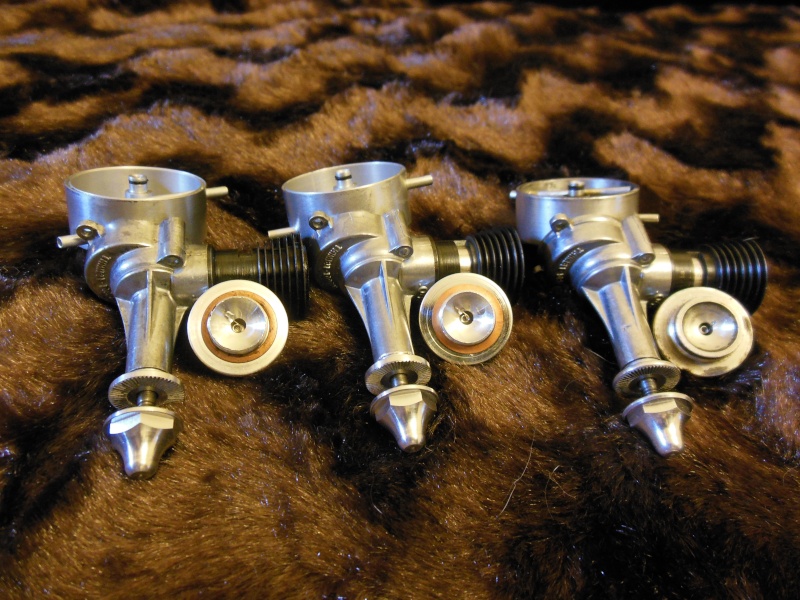
When I dismantled these I realised that the engines with the unlipped crankcase had the older cylinders with the smaller heads. The lipped crankcase had the larger head.

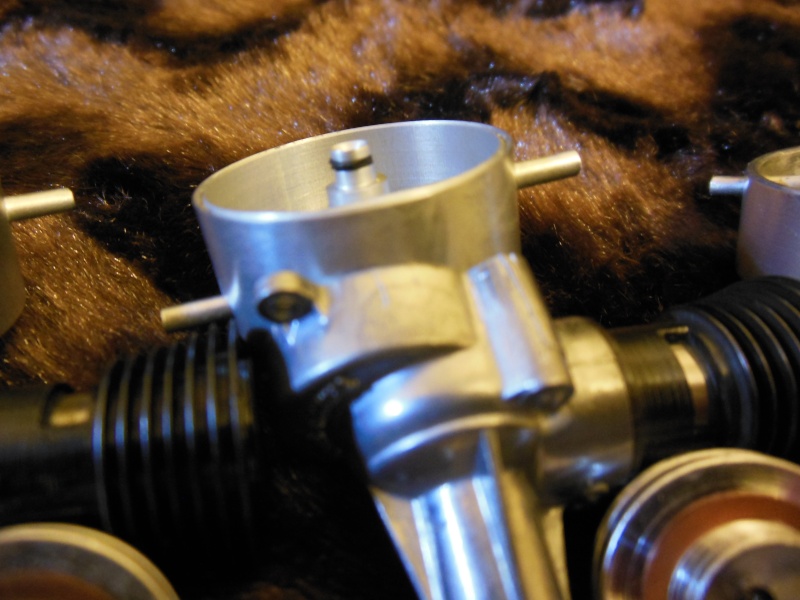
Ready for assembly
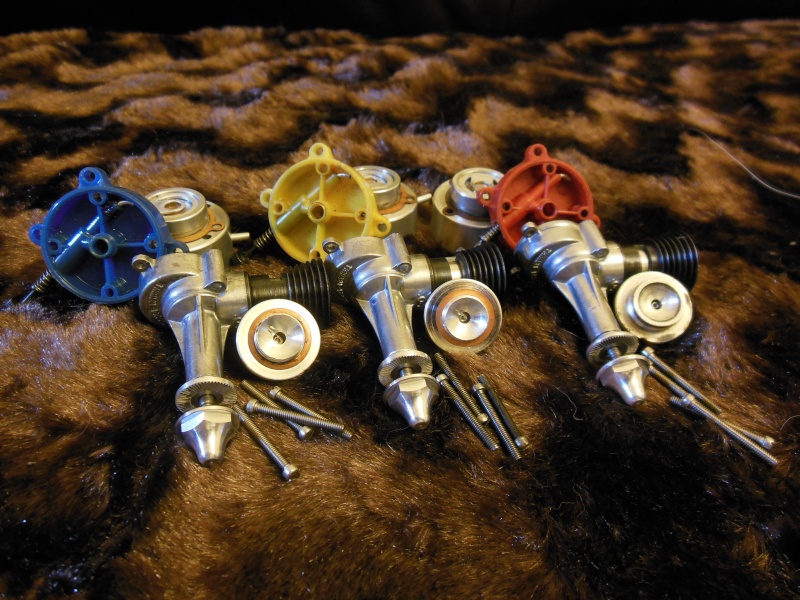
Assembled
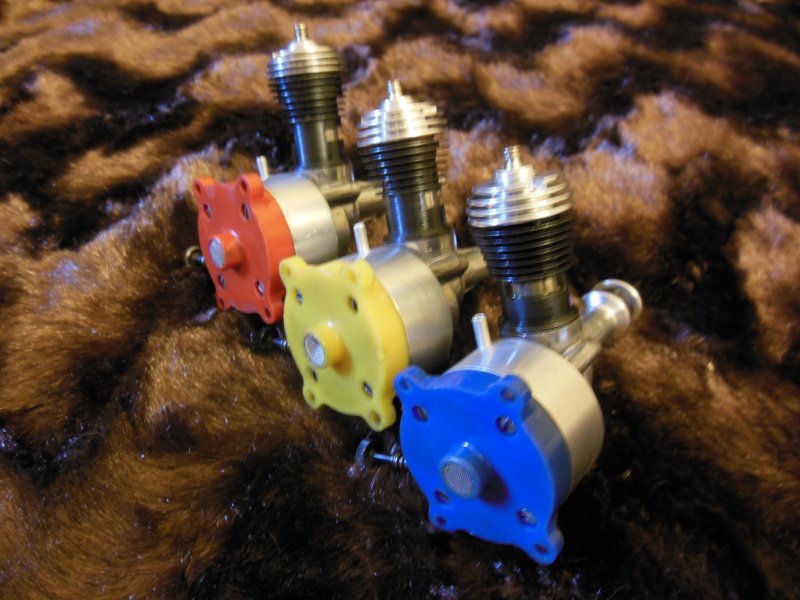
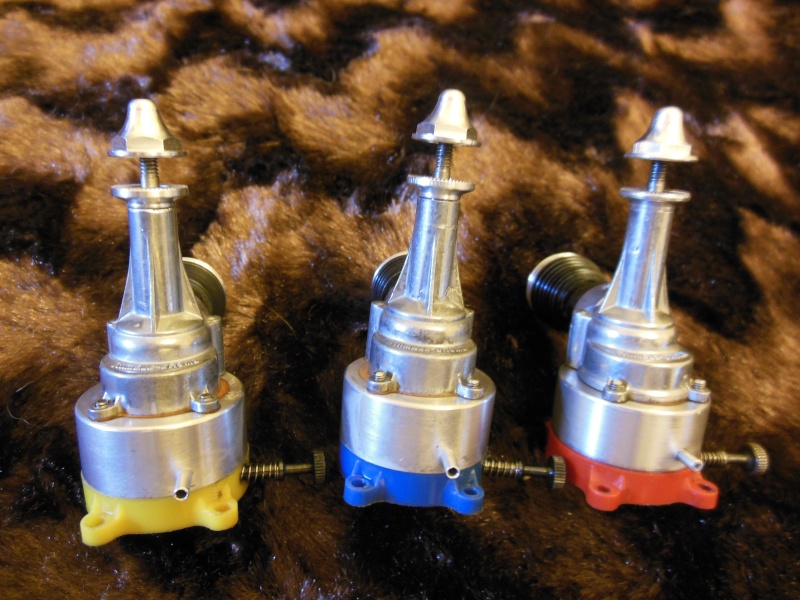
It has also occurred to me that if anyone wanted a full and definite collection of Strato Bugs then with the 3 colours, 2 cylinders and two crankcases - TWELVE would be required to have all permutations!
Thanks to the dog for letting me use her bed (with new faux fir cover!) for the photos.
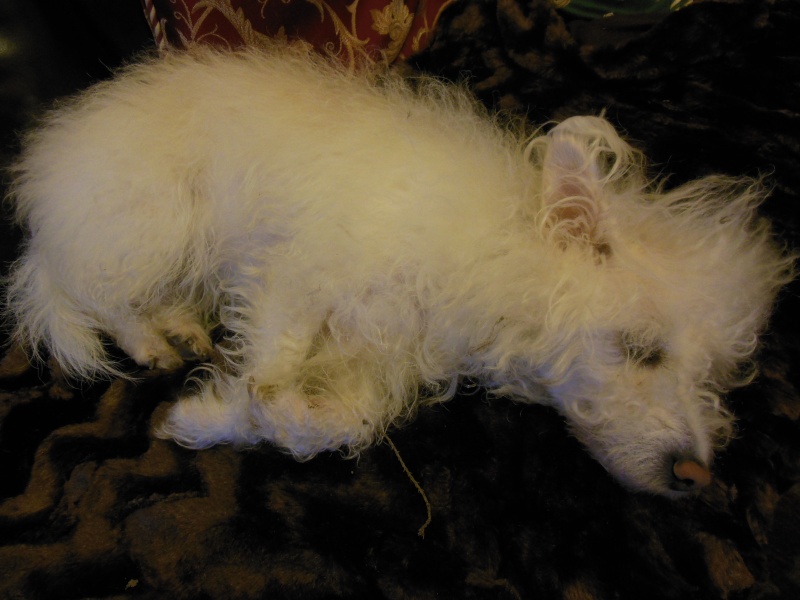

This next picture shows the crankcases and, I hope, a clearer picture of the lipped version on the right.

When I dismantled these I realised that the engines with the unlipped crankcase had the older cylinders with the smaller heads. The lipped crankcase had the larger head.


Ready for assembly

Assembled


It has also occurred to me that if anyone wanted a full and definite collection of Strato Bugs then with the 3 colours, 2 cylinders and two crankcases - TWELVE would be required to have all permutations!
Thanks to the dog for letting me use her bed (with new faux fir cover!) for the photos.


ian1954- Diamond Member

- Posts : 2688
Join date : 2011-11-16
Age : 70
Location : England
 Re: The Strato Bug -Identifying originality
Re: The Strato Bug -Identifying originality
Can you tell me how you cleaned up those Engines Ian? There are nice!! A Blue Strato Bug!! You lucky Dog!! Another Question...Where do you find those "O" Rings if they get lost Ian?? Seen alot pictures of Strato Bug Tanks without these O rings! Thanx!! Love the Blue!! As to your statement of collecting 12 Strato Bugs for a complete meticulous collection?? You would have a better chance of winning the lottery..Finding one Strato Bug is hard enough... Finding 12 Strato Bugs in my life span...I think not! It is nice to dream though! 

ZACATTACK- Gold Member

- Posts : 328
Join date : 2012-04-15
 Answers to your mysteries on Strato Bug and other Bug series engines
Answers to your mysteries on Strato Bug and other Bug series engines
Allow me to preface this with a little on myself:
I worked at Cox doing engine repairs and was trained by Randy Heydon, Dale Kirn, and Kit McNorgan. They were expert authorities on all Cox engines and had over 50 years of combined experience at Cox.
Lipped crankcase is 2nd generation, on all the Bugs( Space, Jr, Strato, and Hopper) This was done to improve sealing of gasket and strengthen the case.
Same applies to the piston/cylinder: Later runs used the improved cylinder and glowhead. With the new cylinder came an improved piston: Cox updated the piston as well and eliminated the aluminum con-rod and "C" clip retainer.
So, in summary, there are generation 1 and generation 2 versions of these early "Bug" engines. Most, but not all of the 2nd generation Bugs came in a plastic blister style packaging with wrench wrapped in the instructions. Most of the 1st generation Bugs came in cardboard boxes with a "Bee" decal.
Due to the cross-over from Gen 1 to Gen 2, and the fact that Cox made thousands of engines daily, there was some cross-over in packaging, crankcases, and glow head/cylinder styles.
If you sent in your Bug for service at Cox (many had a broken crank and case from a crash) you would get it back with the latest parts so you might have gotten the newer case, and cylinder assembly, but still have your old box you bought it in. At Cox, we would often replace your engine with a tested and broken in engine if yours was badly damaged and charge for a full overhaul. In that case, you might get newer version of your engine. We still had old stock of "Bug" parts in customer service when I was at Cox in 1980, and many of us built our own Space Bugs, Thermal Hoppers, Strato Bugs, Jrs, and so on using these parts....so there is undoubtedly quite a few out there that have mix of parts on them due to that.
The main reason Cox changed the cylinder design was because the piston/rod assembly could not hold up to the power, especially when they went to dual bypass porting. The reason Cox went to extruded bar stock cases (Baby Bee, Space Hopper ) was because it was stronger and simpler to manufacture.
BYW, the color of the tank, or backplate was to match the ready to fly, or ready to run product the engine came with. This can be seen on the early Prop Rods and Water Whizzers. Cox offered plain cardboard generic packaged versions of their early RTF and RTR product for distribution by mail order and catalog sales often found in the back of comic books and magazines; these were prizes for selling a certain amount of books of magazines. In addition cereal and dog food companies offered Cox products to customers who turned in a certain amount of box tops or proof of purchase labels as an incentive to them to buy their product. This explains why the Alpo and Friskies versions of the Prop-Rod came in a miss-matched combination of colors.....because they were leftovers that Cox assembled and sold to these companies at a discount..in effect they were factory seconds. So given this, it is very hard to say for certain just what constitutes a genuine Cox built engine, or a parts engine, or complete product because Cox made quite a few versions that were never for sale at the retail level.
Jay
I worked at Cox doing engine repairs and was trained by Randy Heydon, Dale Kirn, and Kit McNorgan. They were expert authorities on all Cox engines and had over 50 years of combined experience at Cox.
Lipped crankcase is 2nd generation, on all the Bugs( Space, Jr, Strato, and Hopper) This was done to improve sealing of gasket and strengthen the case.
Same applies to the piston/cylinder: Later runs used the improved cylinder and glowhead. With the new cylinder came an improved piston: Cox updated the piston as well and eliminated the aluminum con-rod and "C" clip retainer.
So, in summary, there are generation 1 and generation 2 versions of these early "Bug" engines. Most, but not all of the 2nd generation Bugs came in a plastic blister style packaging with wrench wrapped in the instructions. Most of the 1st generation Bugs came in cardboard boxes with a "Bee" decal.
Due to the cross-over from Gen 1 to Gen 2, and the fact that Cox made thousands of engines daily, there was some cross-over in packaging, crankcases, and glow head/cylinder styles.
If you sent in your Bug for service at Cox (many had a broken crank and case from a crash) you would get it back with the latest parts so you might have gotten the newer case, and cylinder assembly, but still have your old box you bought it in. At Cox, we would often replace your engine with a tested and broken in engine if yours was badly damaged and charge for a full overhaul. In that case, you might get newer version of your engine. We still had old stock of "Bug" parts in customer service when I was at Cox in 1980, and many of us built our own Space Bugs, Thermal Hoppers, Strato Bugs, Jrs, and so on using these parts....so there is undoubtedly quite a few out there that have mix of parts on them due to that.
The main reason Cox changed the cylinder design was because the piston/rod assembly could not hold up to the power, especially when they went to dual bypass porting. The reason Cox went to extruded bar stock cases (Baby Bee, Space Hopper ) was because it was stronger and simpler to manufacture.
BYW, the color of the tank, or backplate was to match the ready to fly, or ready to run product the engine came with. This can be seen on the early Prop Rods and Water Whizzers. Cox offered plain cardboard generic packaged versions of their early RTF and RTR product for distribution by mail order and catalog sales often found in the back of comic books and magazines; these were prizes for selling a certain amount of books of magazines. In addition cereal and dog food companies offered Cox products to customers who turned in a certain amount of box tops or proof of purchase labels as an incentive to them to buy their product. This explains why the Alpo and Friskies versions of the Prop-Rod came in a miss-matched combination of colors.....because they were leftovers that Cox assembled and sold to these companies at a discount..in effect they were factory seconds. So given this, it is very hard to say for certain just what constitutes a genuine Cox built engine, or a parts engine, or complete product because Cox made quite a few versions that were never for sale at the retail level.
Jay

jmendoza- Silver Member

- Posts : 70
Join date : 2017-07-18
 Re: The Strato Bug -Identifying originality
Re: The Strato Bug -Identifying originality
Interesting bit of info Jay, it’s what I assumed all along, I suppose originality is just a general consensus. I appreciate you clearing that up.
Care to take on the Black Backplate debacle?
Care to take on the Black Backplate debacle?

Cribbs74- Moderator



Posts : 11907
Join date : 2011-10-24
Age : 50
Location : Tuttle, OK
 Re: The Strato Bug -Identifying originality
Re: The Strato Bug -Identifying originality
Jay I acquired a 57 Bee with 3-piece piston that has a sloppy balljoint connection. Was there any way at COX to repair it similarly to newer pistons that I could also do at home?
Thank you, Andras..(I would love to hear your stories from your time with COX)
Thank you, Andras..(I would love to hear your stories from your time with COX)

balogh- Top Poster



Posts : 4958
Join date : 2011-11-06
Age : 66
Location : Budapest Hungary
 Re: The Strato Bug -Identifying originality
Re: The Strato Bug -Identifying originality
If you have a new rod, and C ring you could remove the C ring and replace the rod to see if that tightens it up. Using a re-set tool will not work. BTW, the re-set tool is only for new engines, or right after break-in, as the ball and socket joints work hardens after the engine has been run a while. Do not attempt to re-set a piston/rod assembly that has been run a long time, as you could damage it.
What is the black back plate debacle?
What is the black back plate debacle?

jmendoza- Silver Member

- Posts : 70
Join date : 2017-07-18
 Re: The Strato Bug -Identifying originality
Re: The Strato Bug -Identifying originality
Thanks Jay yes I know the balljoint hardens znd I reset only engines eith a very few runs on them. Ungirtunately I do not have new rod and C clip for replacement do the 57 Bee remains a shelf queen..

balogh- Top Poster



Posts : 4958
Join date : 2011-11-06
Age : 66
Location : Budapest Hungary
 Re: The Strato Bug -Identifying originality
Re: The Strato Bug -Identifying originality
We once had a Pee Wee hobby engine (red tank) we randomly tested that turned 21,500 on 15%......it was a real honker. When I was not fixing engines or radios, we would test engines for the QA department as we had several engine test booths over in the customer service area. We gave this hot Pee Wee to Dale Kirn in engineering to evaluate and he could not find any measurable differences between it and any other Pee Wee, so Dales analysis was that we screwed up and made one "right" for a change.

jmendoza- Silver Member

- Posts : 70
Join date : 2017-07-18
 Re: The Strato Bug -Identifying originality
Re: The Strato Bug -Identifying originality
Jay it is a funny story with the Pee Wee..I also have a 020 TeeDee that spins the 3-bladed COX prop way faster than it is supposed to do and I have no idea why, but " if it ain't broke you do not want to repair it "...
Was that customer service area with the engine testing booth somewhere behind the glass window building located at 1505 East Warner Avenue in Santa Ana that I visited when in the US a few times?
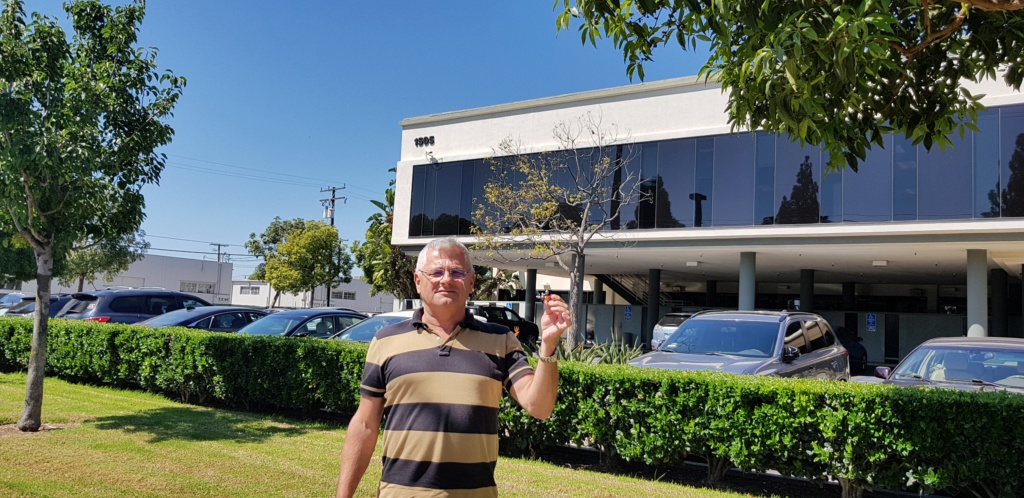
Was that customer service area with the engine testing booth somewhere behind the glass window building located at 1505 East Warner Avenue in Santa Ana that I visited when in the US a few times?


balogh- Top Poster



Posts : 4958
Join date : 2011-11-06
Age : 66
Location : Budapest Hungary
 Re: The Strato Bug -Identifying originality
Re: The Strato Bug -Identifying originality
Customer service used to be in the main 1505 building on Warner, but it was moved to the building to the right on the corner of Warner and Ritchie. This building was referred to as the "Helms" building, as Leroy Cox leased it to the Helms bakery. When Helms quit the lease, they moved customer service and the wood shop for Airtronics into the Helms building to make more room for production in the main plant.
I met Leroy Cox one time during lunch; everyone was gone to lunch but I stayed on working on a particularly difficult radio as it had my attention and I was determined to not let it get the better of me. I noticed a well dressed elderly gentleman walking around outside the radio room and poked my head out to see if I could help him. It was Leroy and he was doing a walk-through of the property, just to make sure everything was OK, as a good landlord should do. He was very nice and we talked a bit about how he had started his business during WWII making wooden pop guns when he really wanted to get into making photographic equipment. He spoke about the fire at the original Pointsetta St. plant, back when he was making spin dizzy cars. Leroy related that he had a biplane he liked to fly over south Orange County, which was rural back then, and do aerobatics. He also told me he made more money leasing the land he owned to Leisure Dynamics than he had when making hobby products!
I met Leroy Cox one time during lunch; everyone was gone to lunch but I stayed on working on a particularly difficult radio as it had my attention and I was determined to not let it get the better of me. I noticed a well dressed elderly gentleman walking around outside the radio room and poked my head out to see if I could help him. It was Leroy and he was doing a walk-through of the property, just to make sure everything was OK, as a good landlord should do. He was very nice and we talked a bit about how he had started his business during WWII making wooden pop guns when he really wanted to get into making photographic equipment. He spoke about the fire at the original Pointsetta St. plant, back when he was making spin dizzy cars. Leroy related that he had a biplane he liked to fly over south Orange County, which was rural back then, and do aerobatics. He also told me he made more money leasing the land he owned to Leisure Dynamics than he had when making hobby products!

jmendoza- Silver Member

- Posts : 70
Join date : 2017-07-18
 Re: The Strato Bug -Identifying originality
Re: The Strato Bug -Identifying originality
I like these stories about the heyday of Cox snd would be happy to read more. Thank you Jay.

balogh- Top Poster



Posts : 4958
Join date : 2011-11-06
Age : 66
Location : Budapest Hungary
 Re: The Strato Bug -Identifying originality
Re: The Strato Bug -Identifying originality
Bill Wisnewsky, John Broadbeck, and Bill Attwood were regular visitors at Cox, I had the pleasure of meeting them several times as they would always drop by the radio room to see my boss Jim Burlile, and Lee Renaud. I worked with Jim Burlile and Big John Elliot, who both had worked at Orbit together. Cliff Weirick also was helping out Lee Renaud at the time by traveling around the USA promoting Airtronics radios. At one point, Cliffy was building a 3/4 size F4U Corsair in the wood shop area of the Helms building where we manufactured the Airtronics kits. He later finished it off at Oceanside/Palomar airport and flew it to many airshows locally. Larry Jolly was one of the guys Lee hired to do wood cutting for the kits, he flew his prototype GMP Cricket helicopter in the warehouse area of the Helms building for us several times. . Bob Novak would drop in to scrounge Sanwa servo plugs I cut off bad servos; he needed them for his NS-1 servos he made for cars and his airborne flight packs. Working at Cox was like going to a who's who meeting of all the southern California R/C company owners.

jmendoza- Silver Member

- Posts : 70
Join date : 2017-07-18
 Re: The Strato Bug -Identifying originality
Re: The Strato Bug -Identifying originality
Great memories...I wonder if that F4U Corsair was also powered by a larger size COX engine? Do you happen to have photos about the East Warner Ave. factory interior and the staff dating back to your time with COX? We saw many photos shot in probably the early 60-s only when Mr Cox was still active..but nothing from later times...or maybe I missed them.

balogh- Top Poster



Posts : 4958
Join date : 2011-11-06
Age : 66
Location : Budapest Hungary
 Re: The Strato Bug -Identifying originality
Re: The Strato Bug -Identifying originality
What is the black back plate debacle?[/quote]
Thanks for posting, good stuff!
Over the years, every now and then a black backplate SBJ shows up, with many claiming they're prototypes, I agree that most if not all were dyed and never marketed.
Also to clarify, only SBJ were made with tanks matching toys, Strato Bugs were sold as hobby engines only.
Thanks for posting, good stuff!
Over the years, every now and then a black backplate SBJ shows up, with many claiming they're prototypes, I agree that most if not all were dyed and never marketed.
Also to clarify, only SBJ were made with tanks matching toys, Strato Bugs were sold as hobby engines only.
 Re: The Strato Bug -Identifying originality
Re: The Strato Bug -Identifying originality
Cliffy's F4U Corsair was a man carry plane, 3/4 of the full size, he flew in it.
I have seen black SBJs show up at collectos, swap shops, and on eBay, rare, but I never paid much attention. Blue and red seem to be less common than yellow for some reason. One thing I learned at Cox was you would find all sorts of colors of plastic parts for planes and engines that they gave us from production for customer service. When they were cleaning up the warehouse we got all kinds of rare old stock and short runs of odd ball colored stuff. For example, we had red and white peppermint wings and fuselages for the PT-19s that came from when they purged the molds from red to white on the fuselages and wings for the QZ series. There was also clear test shots of each mold they ran to check the quality of the molding. Cox made a lot of stuff that never was sold, but got out the door. Half the fun of working there was when we would do clean-ups and discover Cox gold.
I have seen black SBJs show up at collectos, swap shops, and on eBay, rare, but I never paid much attention. Blue and red seem to be less common than yellow for some reason. One thing I learned at Cox was you would find all sorts of colors of plastic parts for planes and engines that they gave us from production for customer service. When they were cleaning up the warehouse we got all kinds of rare old stock and short runs of odd ball colored stuff. For example, we had red and white peppermint wings and fuselages for the PT-19s that came from when they purged the molds from red to white on the fuselages and wings for the QZ series. There was also clear test shots of each mold they ran to check the quality of the molding. Cox made a lot of stuff that never was sold, but got out the door. Half the fun of working there was when we would do clean-ups and discover Cox gold.

jmendoza- Silver Member

- Posts : 70
Join date : 2017-07-18
 Re: The Strato Bug -Identifying originality
Re: The Strato Bug -Identifying originality
jmendoza wrote:Cliffy's F4U Corsair was a man carry plane, 3/4 of the full size, he flew in it.
...
Ooooops, sorry for my blunt question...
 I though it is proportionally larger than a 1/2A size
I though it is proportionally larger than a 1/2A size
balogh- Top Poster



Posts : 4958
Join date : 2011-11-06
Age : 66
Location : Budapest Hungary
 Re: The Strato Bug -Identifying originality
Re: The Strato Bug -Identifying originality
That's some very Cool stuff Jay , Thank You for sharing with us your adventures at Cox  I bet there was some interesting stuff to pick up on at the end of the week or cleaning up
I bet there was some interesting stuff to pick up on at the end of the week or cleaning up 

 I bet there was some interesting stuff to pick up on at the end of the week or cleaning up
I bet there was some interesting stuff to pick up on at the end of the week or cleaning up 


getback- Top Poster



Posts : 10441
Join date : 2013-01-18
Age : 67
Location : julian , NC
Page 1 of 2 • 1, 2 
 Similar topics
Similar topics» Originality, or how to avoid a mongrel...
» Strato Bug NIP
» My first Strato Bug.....maybe
» Strato-Bug
» Strato bug ....or is it?
» Strato Bug NIP
» My first Strato Bug.....maybe
» Strato-Bug
» Strato bug ....or is it?
Page 1 of 2
Permissions in this forum:
You cannot reply to topics in this forum

 Rules
Rules






